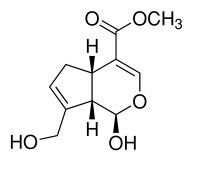Isolation of Geniposide and Genipin
Endo and Taguchi isolated geniposide and genipin using the following method in 1973.� This method is still used however, some modifications have been made.� Figure 5 shows the reaction.
1. The Gardenia jasminoides Ellis fruits are crushed.
2. The crushed fruit is then extracted with CHCl3 to remove the fats and oils and then extracted with MeOH, three times at room temperature.
3. The combined MeOH extracts are then concentrated under reduced pressure until it is dry.� The result of these steps is a brown colored mass.
4. The MeOH extracts are then chromatographed on charcoal using water and 10% aqueous EtOH to separate the sugars.� Then it is chromatographed using MeOH to separate the glycosides.�
5. The glycosidic fraction eluted with MeOH is then rechromatographed on silica gel using a mixture of MeOH and CHCl3.� Geniposide is eluted with a mixture of 7 to 10% MeOH- CHCl3.� The residue is crystallized from acetone and forms colorless crystals.
6. Geniposide and a solution of 1% aqueous solution of β-glucosidase are added to an acetate buffer (pH 5.0).
7. This mixture is allowed to stand at 37�C for three hours.
8. The reaction mixture is extracted with ether.
9. The extract is concentrated and crystallized with ether-MeOH to yield colorless genipin.

Gelatin based materials have recently been studied as a biomaterial for use in bioadhesives, wound dressing material, and bone substitute.� Gelatin is a natural polymer which has a low antigenicity and is biodegradable.� However, gelatin does possess one important limitation.� It rapidly dissolves in aqueous environments, this leads to quick degradation at body temperature.� One method to improve gelatin is by treating it with crosslinking materials.� Chemical crosslinking is normally achieved by creating bonds between functional groups of amino acids.� The most popular chemical crosslinking reagent is glutaraldehyde, a synthetic reagent. Recently, reports of the cytotoxicity of glutaraldehyde due to the release of formaldehyde upon degradation has prompted research into the development of a natural crosslinking reagent.� For this reason, genipin which has low cytotoxicity and is naturally occurring has been investigated as a new crosslinking reagent for gelatin.
Genipin is a naturally occurring material that shows great potential as a use in biomaterials and also as a fingerprint reagent.� As stated earlier genipin crosslinked material has been use as a bioadhesive, in wound dressing materials, and as a bone substitute.� In addition to these studies, studies have also been conducted to investigate genipin crosslinked gelatin as a conduit for peripheral nerve regeneration and genipin crosslinked chitosan for protein drug delivery.� Based on these novel experiments, I believe that genipin will become an important crosslinking reagent for biomaterials in the future.
FineSky Genipin 98% is on hot sale recently, welcome your inquiry. Any questions, please call us at 86-29-88897831 or send us email info@fineskybiotech.com

Gelatin based materials have recently been studied as a biomaterial for use in bioadhesives, wound dressing material, and bone substitute.� Gelatin is a natural polymer which has a low antigenicity and is biodegradable.� However, gelatin does possess one important limitation.� It rapidly dissolves in aqueous environments, this leads to quick degradation at body temperature.� One method to improve gelatin is by treating it with crosslinking materials.� Chemical crosslinking is normally achieved by creating bonds between functional groups of amino acids.� The most popular chemical crosslinking reagent is glutaraldehyde, a synthetic reagent. Recently, reports of the cytotoxicity of glutaraldehyde due to the release of formaldehyde upon degradation has prompted research into the development of a natural crosslinking reagent.� For this reason, genipin which has low cytotoxicity and is naturally occurring has been investigated as a new crosslinking reagent for gelatin.
Genipin is a naturally occurring material that shows great potential as a use in biomaterials and also as a fingerprint reagent.� As stated earlier genipin crosslinked material has been use as a bioadhesive, in wound dressing materials, and as a bone substitute.� In addition to these studies, studies have also been conducted to investigate genipin crosslinked gelatin as a conduit for peripheral nerve regeneration and genipin crosslinked chitosan for protein drug delivery.� Based on these novel experiments, I believe that genipin will become an important crosslinking reagent for biomaterials in the future.
FineSky Genipin 98% is on hot sale recently, welcome your inquiry. Any questions, please call us at 86-29-88897831 or send us email info@fineskybiotech.com
| FineSky Hot Products: Green Coffee Bean Extract | Goji Berry | Resveratrol | Milk Thistle Extract | Green Tea Extract |
| Copyright © 2013 Xi’an FineSky Technological Co.,Ltd.All Rights Reserved. |Site Map | 陕ICP备17001729号-1 |




